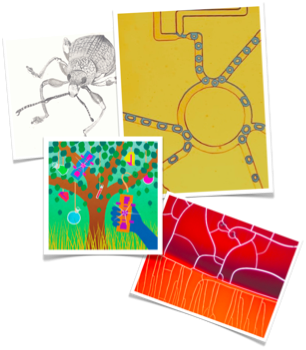
Cabinets of Curiosity
Historically, "Cabinets of Curiosity" were physical cabinets (or rooms) containng a collection of objects which could not be categorized (or understood metadologically) in any way. Since I primarily run a curiosity driven lab, I am fascinated with this Renaissance notion of collecting objects, ideas and problems that don't fit our current framework of thinking.
Mostly I will use this space to share my thoughts on science (akin of a blog), highlight mentorship advice for young scientists (like myself) and just share with a general audience why (and how) we do science.
Feel free to write me any comments you might have.
cheers, manu
April 26, 2013: Finding Mentors in science
Nature's guide for mentors
I am thinking about mentorship today. In all fields, and very explicitly in arts. the role of mentor is highlighted so explicitly. A musician always has in the back of his head a mentor who guided him along and a key role a person played in development of a person's craft (or career). Strangely, we don't often talk about it in Science. Linked above is a great piece that gives examples and guidance to people who are taking on roles as mentors (like myself) but also seasonal people who might have just gotten a little too comfortable with the idea of mentorship and forgotten what it really is for. If you are a student, you should read this carefully and make sure you directly seek mentors that fit criterias listed. If you are a student seeking a mentor, one experience from my own past, is never be too shy to ask.
Dec 7, 2012: Journey we call "Science": Lasker Medical Research Award essay's this year. Nature Medicine Link
In continuation of the theme of "journey in science" and variations of paths people take, I found these essay's by 2012 Lasker Award winners quiet inspirational.
Some highlights include the role of "Spudich Electric Company" - also an advice worth repeating from Jim's essay: Quote "Get as much interdisciplinary training as you can early in your career, work on what you are captivated by and stay focused on the essential issues." Another fascinating anecdote revealed in the essay includes how Bio-X was founded (an interdiscplinary group to which we belong).
Ron's essay is more geared towards advise for young investigators. It's really worth in gold, so I am going to repeat his ten lessons "word to word": Quote
1. Find good mentors, learn from them and then develop your own style.
2. Pick an important problem.
3. Get ahead but then take a chance: seek adventure.
4. Read literature, but don't be crippled by it.
5. You don't need a fancy lab to do good science.
6. Work hard, play hard and squeeze in time to do your laundary.
7. Persistence is more important than brillance.
8. No project or career is immune from mistakes.
9. Don't be afraid to change your life plans.
10. Science is moving fast: hold on and enjoy the ride.
Dec 4, 2012: Insect soap opera. NYTimes article
The Entomological Society of America ran an insect video competition. Wish they had more entries (compared to number of insect loving citizens), but still some really fun video footage to watch. This is giving me ideas about remaking bugs with "real" bugs..
Nov 15, 2012: One hundered reasons for being a scientist. PDF Link
A week ago, a friend pointed out this document to me. Thinking this will be another set of sterotypes for scientists; I was thrilled to discover this short story thriller (real stories) of scientists (some known and many unknown faces). The only thing that resonates in each of the story is passion for what scientists do: which is science. Everything else: where you are from, how much you have to eat and what you were trained as, almost fades away. The suspense is provided by the curious inroads scientists take (theoretical physicist in this case). Hope you enjoy this as much as I did.
One lesson that I learned was in de Gennes essay, and I quote, "Close cooperation between experimentalists and theoreist in a group can be achieved with an optimal ratio of ~ 1 theorist /5 experimentalist." That is a good ratio to know about.
© Prakash Lab 2016 | Stanford University

